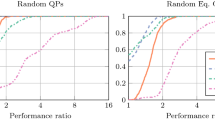Abstract
In this paper we propose a recursive quadratic programming algorithm for nonlinear programming problems with inequality constraints that uses as merit function a differentiable exact penalty function. The algorithm incorporates an automatic adjustment rule for the selection of the penalty parameter and makes use of an Armijo-type line search procedure that avoids the need to evaluate second order derivatives of the problem functions. We prove that the algorithm possesses global and superlinear convergence properties. Numerical results are reported.
Similar content being viewed by others
References
B. Bank, J. Guddatt, D. Klatte, B. Kummer and K. Tammer,Non-linear Parametric Optimization (Birkhäuser, Basel, 1983).
M.C. Bartholomew-Biggs, “ALRQP for inequality constraints,” Technical Report No. 150, Numerical Optimisation Centre, Hatfield Polytechnic (Hatfield, 1984).
M.C. Biggs, “On the convergence of some constrained minimization algorithms based on recursive quadratic programming,”Journal Institute of Mathematics and its Applications 21 (1978) 67–82.
D.P. Bertsekas,Constrained Optimization and Lagrange Multiplier Methods (Academic Press, New York, 1982).
P.T. Boggs, J.W. Tolle and P. Wang, “On the local convergence of quasi-Newton methods for constrained optimization,”SIAM Journal on Control and Optimization 20 (1982) 161–171.
R.M. Chamberlain, “Some examples of cycling in variable metric methods for constrained minimization,”Mathematical Programming 16 (1979) 378–383.
R.M. Chamberlain, C. Lemarechal, H.C. Pedersen, and M.J.D. Powell, “The watch-dog technique for forcing convergence in algorithms for constrained optimization,”Mathematical Programming Study 16 (1982) 1–17.
T.F. Coleman and A.R. Conn, “Nonlinear programming via an exact penalty function method: asymptotic analysis,”Mathematical Programming 24 (1982) 123–136.
T.F. Coleman and A.R. Conn, “Nonlinear programming via an exact penalty function method: global analysis,”Mathematical Programming 24 (1982) 137–161.
J.W. Daniel, “Stability of the solution of definite quadratic programs,”Mathematical Programming 5 (1973) 41–53.
G. Di Pillo and L. Grippo, “A continuously differentiable exact penalty function for nonlinear programming problems with inequality constraints,”SIAM Journal on Control and Optimization 23 (1985) 72–84.
G. Di Pillo and L. Grippo, “An exact penalty method with global convergence properties for nonlinear programming problems,”Mathematical Programming 36 (1986) 1–18.
L.C.W. Dixon, “Exact penalty function methods in nonlinear programming,” Technical Report No. 103, Numerical Optimisation Centre, Hatfield Polytechnic (Hatfield, 1979).
L.C.W. Dixon, “On the convergence properties of variable metric recursive quadratic programming methods,” Technical Report No. 110, Numerical Optimisation Centre, Hatfield Polytechnic (Hatfield, 1980).
R.E. Fletcher, “Second order corrections for nondifferentiable optimization,” in: G.A. Watson, ed.,Numerical Analysis Dundee 1981 (Springer, Berlin, 1982) pp. 144–157.
R. Fontecilla, T. Steihaug and R.A. Tapia, “A convergence theory for a class of quasi-Newton methods for constrained optimization,”SIAM Journal on Numerical Analysis 24 (1987) 1133–1151.
M. Fukushima, “A successive quadratic programming algorithm with global and superlinear convergence properties,”Mathematical Programming 35 (1986) 253–264.
D. Gabay, “Reduced quasi-Newton methods with feasibility improvement for nonlinearly constrained optimization,”Mathematical Programming Study 16 (1982) 18–44.
P.E. Gill, W. Murray, M.A. Saunders and M.H. Wright, “Sequential quadratic programming methods for nonlinear programming,” in: E.J. Haug, ed.,Computer Aided Analysis and Optimization of Mechanical System Dynamics, NATO ASI Series Vol. F9 (Springer, Berlin, 1984).
T. Glad and E. Polak, “A multiplier method with automatic limitation of penalty growth,”Mathematical Programming 17 (1979) 140–155.
S.P. Han, “Superlinearly convergent variable metric algorithm for general nonlinear programming problems,”Mathematical Programming 11 (1976) 263–282.
S.P. Han, “A globally convergent method for nonlinear programming,”Journal of Optimization Theory and Applications 22 (1977) 297–309.
W. Hock and K. Schittkowski,Test Examples for Nonlinear Programming Codes (Springer, Berlin, 1981).
N. Maratos, “Exact penalty function algorithms for finite dimensional and control optimization problems,” Ph.D. Thesis, Imperial College of Science and Technology (London, 1978).
D.Q. Mayne and E. Polak, “A superlinearly convergent algorithm for constrained optimization problems,”Mathematical Programming Study 16 (1982) 45–61.
M.J.D. Powell, “A fast algorithm for nonlinearly constrained optimization calculations,” in: G.A. Watson, ed.,Numerical Analysis Dundee 1977 (Springer, Berlin, 1978) pp. 144–157.
M.J.D. Powell, “The convergence of variable metric methods for nonlinear constrained optimization calculations,” in: O.L. Mangasarian, R.R. Meyer and S.M. Robinson, eds.,Nonlinear Programming 3 (Academic Press, New York, 1978) pp. 27–63.
M.J.D. Powell, “Variable metric methods for constrained optimization,” in: A. Bachem, M. Grötschel and B. Korte, eds.,Mathematical Programming, The State of the Art (Springer, Berlin, 1983) pp. 288–311.
M.J.D. Powell, “Methods for nonlinear constraints in optimization calculations,” Report DAMTP 1986/NA5, University of Cambridge (Cambridge, 1986).
M.J.D. Powell and Y. Yuan, “A recursive quadratic programming algorithm that uses differentiable exact penalty functions,”Mathematical Programming 35 (1986) 265–278.
M. Sahba, “Globally convergent algorithm for nonlinearly constrained optimization problems,”Journal of Optimization Theory and Applications 52 (1987) 291–309.
K. Schittkowski, “The nonlinear programming method of Wilson, Han and Powell with augmented Lagrangian type line search function,”Numerische Mathematik 38 (1981) 83–114.
J. Stoer, “Principles of sequential quadratic programming methods for solving nonlinear programs,” in: K. Schittkowski, ed.,Computational Mathematical Programming, NATO ASI Series Vol. F15 (Springer, Berlin, 1985) pp. 165–207.
K. Tone, “Revisions of constraint approximations in the successive QP method for nonlinear programming problems,”Mathematical Programming 26 (1983) 144–152.
Author information
Authors and Affiliations
Rights and permissions
About this article
Cite this article
Di Pillo, G., Facchinei, F. & Grippo, L. An RQP algorithm using a differentiable exact penalty function for inequality constrained problems. Mathematical Programming 55, 49–68 (1992). https://doi.org/10.1007/BF01581190
Received:
Revised:
Issue Date:
DOI: https://doi.org/10.1007/BF01581190




